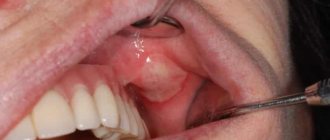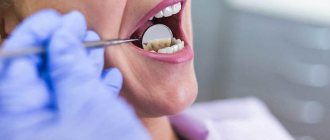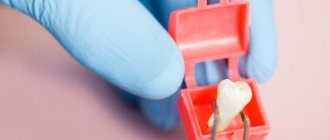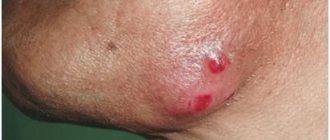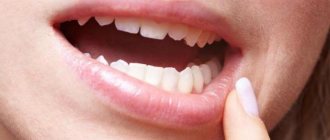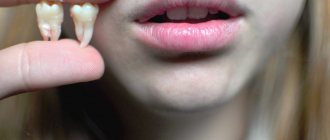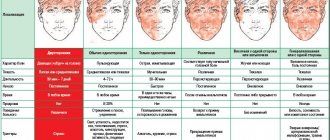It is generally accepted that swelling of the cheek signals problems with teeth. This is not always the case. Toothache can occur without visible external signs. If your teeth don’t hurt, the inflammatory process is probably caused by something else.
There may be several reasons for swelling of the gums and cheeks:
- oral disease;
- insufficient oral hygiene;
- consequences of incorrect dental treatment;
- allergy to filling material;
- nerve removal;
- failure to follow the doctor’s recommendations after removal;
- neurology;
- ear disease;
- sore throat;
- "piggy";
- a bite of an insect.
Problems with internal organs - heart, kidneys, pancreas - can also cause swelling of the cheeks. In any case, only a doctor can make an accurate diagnosis based on test results.
Gum inflammation
There are as many reasons for swollen gums as there are for cheeks. The cause may be mechanical trauma, burns, cysts, or the development of infection. Severe inflammation causes the disease gingivitis.
If the disease is not treated promptly, it leads to periodontal disease and further tooth loss. When the cause of swelling is dental problems, it is easy to understand by the gums. They start to get sick.
Incorrect growth
The eruption of wisdom teeth is often associated with complications. If a tooth grows incorrectly, it begins to turn towards the neighboring tooth or cheek. Inflammation of the gum tissue begins, which accompanies pain. It seems that both my head and jaw hurt.
The pain radiates to the temple, ear, throat. Lymph nodes may become enlarged and a stench may appear. The angle of inclination of the tooth can be very large. This leads to numbness in the lips and cheeks.
Danger of condition
Incorrectly erupting figure eights pose a threat not only to the oral cavity, but also to the body as a whole. Untimely assistance from specialists leads to blood infection. The infiltrate that has been in the oral cavity for a long time does not find a way out and breaks out. The tissues of the neck and jaw have a loose structure, which contributes to the rapid spread of pathogenic flora from the head down. In advanced cases, the situation is life-threatening.
Another danger posed by an erupting wisdom tooth is malocclusion. Due to an incorrectly positioned unit, other elements in the oral cavity are also displaced. Malocclusion leads to inadequate chewing of food, distortion of diction and aesthetic defects. Insufficient grinding of food products leads to dysfunction of the digestive organs. Aesthetic defects cause prolonged depression and neurological problems in the patient.
If the figure eight grows into the cheek, then injury to the mucous membranes of the mouth is possible. Chronic non-healing ulcers appear on their surface. Microdamages cause pain to a person with every meal and conversation.
Read also: Where is the 25th tooth located?
If a wisdom tooth grows for a long time and hurts, then intoxication of the body is possible, manifested by nausea and increased body temperature. The patient's condition worsens and it becomes difficult for him to cope with daily activities.
Abscess
If you do not promptly treat the inflamed gums at the site of the growing wisdom tooth, then deterioration will follow. Inflammation will develop into a more complex form. The abscess will affect a large area of the jaw and lead to surgery.
The tumor can reach very large sizes. Examples of wisdom tooth swelling can be seen in the photos presented.
If the abscess has gone far, then serious health problems will appear. The following symptoms of a purulent process will occur:
- It's hard to open your mouth. The infection affected the masticatory muscle. This can lead to muscle paralysis and hospitalization.
- A red or blue tumor appeared on the cheek, opposite the wisdom tooth.
- Difficulty swallowing. Changes have occurred near the root of the tongue.
- The temperature remains high.
- The nature of the pain changes. It is getting stronger every hour. Its abrupt cessation should be alarming. Pus could break out of the abscess into the tissue.
Note!
Pain after wisdom tooth removal - possible complications and duration of pain after removalRemoval of a wisdom tooth - indications, features and main stages of the removal operation
How many wisdom teeth are there - the structure and features of jaw development. Number, height, teething, doctors’ recommendations for their treatment and removal
Signs of cutting eights
Symptoms of the onset of teething or why the gums near the last tooth hurt and are swollen:
- The gums above the future wisdom tooth are swollen. Such swelling immediately at the moment of teething often occurs due to inflammation of the so-called “hood” formed above the tooth. It is a section of gum that hangs over the tooth;
- Difficulty opening the mouth. This sign is very unfavorable and indicates the active growth of the inflammatory process with its spread to the area of the masticatory muscle. It is important to visit a specialist immediately, otherwise over time the mouth will stop closing completely. When the inflammation becomes so complicated, the patient can only get help in a hospital;
- The gums are swollen right next to the wisdom tooth and it hurts to swallow. This sign is no less dangerous and may indicate the beginning of the development of a purulent abscess around the figure eight, closer to the tongue area (which is why it hurts a person to swallow). This is too dangerous a place for inflammation, because purulent contents can quickly move to the bottom of the oral cavity. In this case, phlegmon undoubtedly forms, the treatment of which requires long-term therapy with mandatory surgical intervention;
Painful sensations. As you know, the manifestation of pain is appropriate for any inflammatory reaction of the body, and the inflamed figure eight hood is no exception. The longer you ignore a visit to the doctor, the more intense the pain will be. But it is worth remembering that sometimes sudden relief cannot be associated with the elimination of inflammation; perhaps purulent contents have come out from under the gums into nearby tissues;- Increased body temperature. During the period when wisdom teeth are being cut, the presence of a temperature of 37.5 is considered within normal limits. But still, an increase may signal the development of inflammation under the hood of the figure eight. And the more actively the source of inflammation spreads, the more the thermometer will grow. Often, a not too high temperature is observed with the growth of eights without pain, swelling of the gums or cheeks.
Why does the gum around the wisdom tooth still hurt and swell? Such discomfort may be due to a lack of space where the molar is cut. In such a situation, the figure eight tries to increase the free space in the dentition, thereby displacing all the teeth. That is, with sufficient force he presses on the neighboring seven, which presses on the six, and so the entire row of teeth shifts along the chain. Such massive pressure on the teeth can cause severe pain to a person.
What to do if your wisdom tooth is swollen
If pain occurs or swelling appears, it is better not to wait, but to immediately go to the clinic. The location of the outer teeth makes treatment difficult. Especially in an advanced stage. What to do if your wisdom tooth starts to swell.
Dentists recommend removing such teeth as early as possible surgically. Modern technologies allow this operation to be performed painlessly and effectively.
It is not possible to treat an inflamed gum on your own. At home, suffering can be reduced only slightly. There are several simple ways to relieve swelling of wisdom teeth. In an emergency, you can rinse your mouth with soda or use pharmaceutical drugs that will dull the pain and reduce the temperature.
Strictly prohibited
Wanting to get rid of pain as quickly as possible, out of ignorance you can use the wrong remedy and cause yourself even more harm.
It is strictly forbidden to make hot or even warm compresses, they will only aggravate the inflammatory process. Antibiotics will make the situation worse.
Note!
- Impacted wisdom tooth - indications for removal and postoperative recovery period
Wisdom tooth pain - causes of pain and tips on how to relieve pain at home
- A wisdom tooth is inflamed - a step-by-step description of the process of inflammation, treatment and postoperative recovery
Do not take painkillers before visiting the dentist or before surgery. This will prevent the doctor from making an accurate diagnosis. In case of emergency surgery, aspirin taken the day before will cause bleeding.
In order not to take the situation to an extreme, if the gums above the wisdom tooth become inflamed, you should immediately consult a dentist. The doctor will prescribe the necessary treatment and help avoid complications.
Emergency measures
What to do if your wisdom tooth is cutting out and your gums hurt? It is not always possible to consult a specialist at the first pathological signs. It is also possible to relieve discomfort at home. To do this, the oral cavity is rinsed with soda or saline solutions. They will help slow down the spread of pathogenic flora and reduce the intensity of inflammation. Solutions are prepared according to the following recipe: 1 tsp. soda or salt is dissolved in 200 ml of boiling water. The rinsing procedure is carried out every 2 hours.
If the cheek is swollen due to caries, then it is better to use herbal tinctures and decoctions. The ideal option is crushed horsetail mixed with honey. To rinse the mouth if there is a problem, use an alcoholic tincture of fennel and horseradish: the plants are crushed and mixed in equal proportions. Plant materials are poured with vodka and left for 3-4 hours. The use of alcohol tinctures is prohibited for patients who have ulcers in the mouth. Otherwise, emergency measures will lead to burns of the mucous membranes.
What painkillers can be used if a wisdom tooth is coming out and your cheek hurts? In this situation, potent tablets, which are usually prescribed by a doctor, are suitable. When taken independently, side effects may develop, such as stomach bleeding or lack of effect from taking the medication. For this reason, taking painkillers for more than 3-5 days without consulting a doctor is prohibited.
A common group of medications used for toothaches are analgesics. Medicines provide a calming effect for several hours before visiting the dentist. From this group of drugs Analgin, Pentalgin, Tempalgin are used. Ibuprofen-based products - Nurofen, Nimesil, Bonifen - have a more powerful therapeutic effect. The drugs not only reduce pain, but also have an anti-inflammatory effect.
Aspirin and Paracetamol will help relieve suffering. You should not count on a powerful pain-relieving effect from taking these medications.
List of the most powerful drugs used for pain in the cheek during teething:
If the cause of the problem is related to the eruption of a rotten third molar, then an anesthetic can be applied to the tooth. To do this, the tablet is crushed into powder and poured into the carious cavity. It is necessary to ensure that the drug does not get on the gums and mucous membranes, otherwise even greater inflammation may develop.
Cooling gels - Cholisal, Kamistad, Dentol, Metrogyl - will help temporarily cope with the signs of a growing figure eight. Additionally, the sore spot is rinsed with antiseptics - Miramistin, Chlorhexidine, Furacilin.
Read also: Tooth grows into cheek
What to do if your cheek is swollen from a wisdom tooth, and you don’t have the appropriate medications at hand? You can soak a cotton swab in propolis tincture or valerian and apply it to the problem area. You can rinse your mouth with vodka (in the absence of ulcers and open wounds on the mucous membranes). Sea buckthorn oil has a good anti-inflammatory and analgesic effect. It does not damage the mucous membranes and is considered safe in the treatment of toothaches.
Photo of a swollen wisdom tooth

Join the discussion of the article:
Site search
Recommendations
Sangviritrin - instructions for use of the solution and indications for use for dental problems
Mouth spray: the best formulations with prebiotics, their cost and application features
Falimint - reviews, instructions for use and expert assessment of effectiveness
Stomatofit - complete instructions for use, dosage, selection of analogues and price comparison
Ketorol for toothache - reviews of use and effectiveness. Cost and dentists’ opinions about the medicine
Antibiotics for flux: the most effective remedies and tips on choosing medications for children and adults
Metrogil denta - analogues, advantages of use, composition features and indications for use
Periodontocide - means for prevention, release form, methods of application and indications for use
Medicine for teeth - rating of the best remedies for eliminating pain and relieving swelling. Doctors' advice and cost of the most effective drugs
Medicine for gums - the most effective gels, ointments and tablets for relieving pain and discomfort
Blue for stomatitis - methods and features of using the medicine for children and adults
Cholisal is a dental gel for gums and oral cavity. Price and instructions for use
Kamistad gel - instructions for use, features of use, composition, indications and contraindications
Lincomycin - instructions for use, cost, reviews from patients and doctors
Ointment for gums - the choice of the most effective healing and anti-inflammatory agents
Ibuprofen - clinical practice, instructions for use and safety tips
Pain after wisdom tooth removal - possible complications and duration of pain after removal
Removal of a wisdom tooth - indications, features and main stages of the removal operation
Toothpicks - benefits, harm and tips for choosing safe toothpicks from the best materials
Bone dental implantation – myths and truth about bone tissue augmentation. Step-by-step description of the operation
Sections
Most read on the site:
A tooth hurts at night The sky in the mouth hurts Vitamins for teeth Inflammation of the gums Inflammation of the tooth Gel for gums Herpes in the mouth Dental hygiene Gorpils Dekasan Dental floss Tartar Plaque Ibuprofen Irrigator How to choose a mouthwash How to brush your teeth Kamistad gel Bleeding gums Medicine for gums Medicine for teeth Cavity treatment mouth Lincomcin ointment for gum metrogil denta nystatin swollen upper lip whitening paste gums gums periodontocide Prevention Pomic in the mouth Solution to the oral cavity of Sinki sinky from stomatitis spray spray stomatophytite dentistry in the gums, ultrasound halitosis Hepilor Holisal Crunches the jaw Itchy teeth Cleaning gums Splinting teeth Mouth ulcers
Copyright © 2020 ZubkiExpert.Ru is a leading online portal about dentistry. Modern methods of diagnostics and dental treatment! Home | Sitemap | Dentist consultation
Symptoms
An interesting fact is that the appearance of the upper “eights” is almost asymptomatic. The only inconvenience after the growth of these specimens may be a strong deviation towards the cheek, which at first causes a certain inconvenience and traumatizes its inner surface. Lower wisdom teeth can cause serious problems for the “owner”. And it’s good if their “birth” is accompanied only by pain.
We suggest you read: Why gums swell after tooth extraction
The eruption of the “eight”, especially the lower one, is accompanied by inflammation of the tissue under which the tooth grows. The gums become swollen and redness appears. If there is not enough space for him, then his neighbors may suffer, whom the atavistic tooth tries to move, and microtraumas appear on the tongue. Remaining under the gum hood for a long time, it can cause intoxication of the entire body. If the case is severe, suppuration may form.
Sometimes it happens that only the upper part of the wisdom tooth is shown, and the process of further growth is suspended. Along the edges of this peculiar peak, periodontal tissue hangs over, “pockets” are formed, which over time turn into foci of pathogenic microflora, since it is extremely problematic to remove food debris from such places on your own. As a result, bad breath appears, and the remaining teeth are at risk of caries.
If the gums in the area of the last tooth are swollen and painful, there is no need to search on the Internet for the answer to the question “what to do?” You need to visit your nearest dental clinic as soon as possible.

